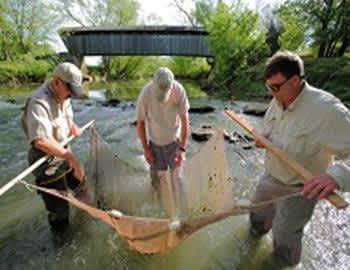Not All Exotic Fish Species are Welcome in Kentucky’s Public Waters

In the 1870s, fishery scientists began to consider stocking exotic fish species into U.S. waters to compensate for the loss of native species.
The brown trout (Salmo trutta), a native of Europe, is arguably the biggest success story, having been first introduced into the Baldwin River in Michigan in 1884.Today, brown trout are thriving throughout North America, South America, Australia and New Zealand.
In Kentucky, brown trout are stocked annually in 10 streams and three tailwaters. The state record, caught from the Cumberland River in 2000, weighed 21 pounds.
But not all exotic fish species are welcome in Kentucky public waters, as many introductions, intentional or otherwise, have proven to be detrimental to native fish populations.
Kentucky Administrative Regulation 301 KAR 1:122 states that “no live fish, live bait fish or live bait organisms that are not native or established in Kentucky waters shall be bought, sold, possessed, imported, or in any way used or released into waters of this Commonwealth.”
Also in that regulation is a list of exotic fish species that may not be imported, sold or possessed in captivity in Kentucky. This includes the piranha, Mexican banded tetra, sea lamprey, walking catfish or snakehead.
“The problem with a lot of exotics is they have a really high recruitment rate. They produce more young, so they gain an advantage over our native fish species,” said Jeff Ross, assistant director of the Fisheries Division for the Kentucky Department of Fish and Wildlife Resources. “They are often voracious feeders, too. They eat the same plankton or forage as our native fish species, so they directly compete against them.”
Asian carp, which include silver and bighead carp, escaped from fish culturists in Arkansas in the late 1970s. They are now present in significant numbers in the Mississippi, Ohio, Tennessee, lower Cumberland, lower Kentucky, lower Salt, and lower Green river basins in Kentucky.
A serious concern is that holders of sport fishing licenses, who can legally take live bait with seines and cast nets from public waters, run the risk of unknowingly spreading the invasive carp species to other streams and lakes in Kentucky. Asian carp compete directly with native sport fish species because they feed on zooplankton.
Young silver carp look remarkably similar to the threadfin and gizzard shad that anglers target for bait. “Use live bait where you catch it,” said Ross. “Don’t transport live bait to other river systems or any lake. When you’re done fishing it’s best to dump your bait on the shore, just to be on the safe side.”
The alewife (Alosa pseudoharengus) is a forage fish that became established in Kentucky in the 1990s, thriving in the deep, cool waters of Lake Cumberland. “Then we noticed that alewives have started to show up in three of our walleye lakes (Laurel River Lake, Carr Creek Lake and Green River Lake), and in Barren River Lake,” said Ross.
Alewives not only feed on plankton that sport fish eat, but the sport fish themselves, when they are newly-hatched.
“In studies on Carr Creek Lake we found that once alewives get a foothold, their populations expand rapidly, at the expense of shad,” said Ross. “At one time they made up nearly half of the lake’s forage base. They grow so fast after hatching that they were too large for the newly-stocked walleye to eat.”
The establishment of exotic fish populations has spawned a whole new set of issues that anglers and fishery biologists alike will have to address in the future as competition for food and space in Kentucky’s rivers and lakes increases.

